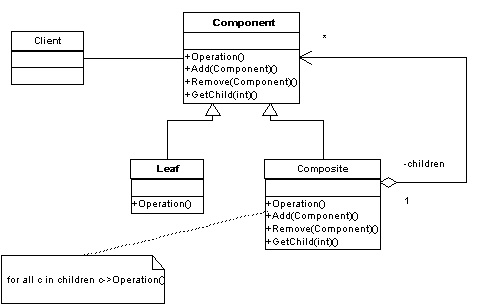Composite
Definition
Compose objects into tree structures to represent part-whole hierarchies. Composite lets clients treat individual objects and compositions of objects uniformly.
Class Diagram

Participants
-
Component
- declares the interface for objects in the composition.
- implements default behavior for the interface common to all classes, as appropriate.
- declares an interface for accessing and managing its child components.
- (optional) defines an interface for accessing a component's parent in the recursive structure, and implements it if that's appropriate.
-
Leaf
- represents leaf objects in the composition. A leaf has no children.
- defines behavior for primitive objects in the composition.
-
Composite
- defines behavior for components having children.
- stores child components.
- implements child-related operations in the Component interface.
-
Client
- manipulates objects in the composition through the Component interface.
Benefits
- Define class hierarchies consisting of primitive objects and composite objects.
- Makes it easier to add new kind of components.
- Provides flexibility of structure and manageable interface.
Usage
- When you want to represent the whole hierarchy or a part of the hierarchy of objects.
- When you want clients to be able to ignore the differences between compositions of objects and individual objects.
- When the structure can have any level of complexity andis dynamic.